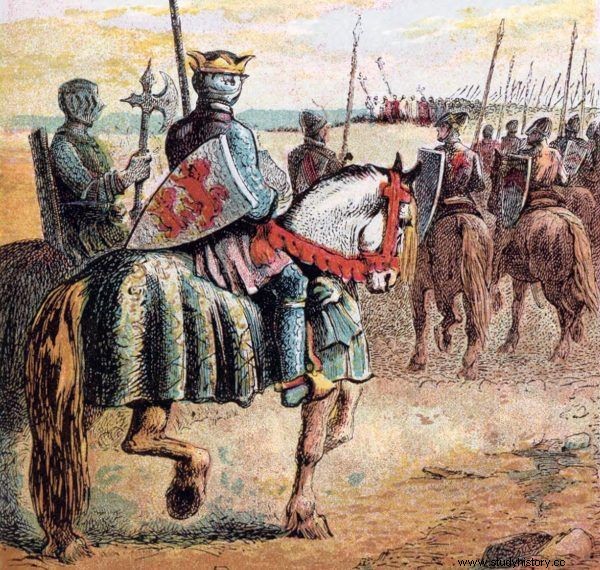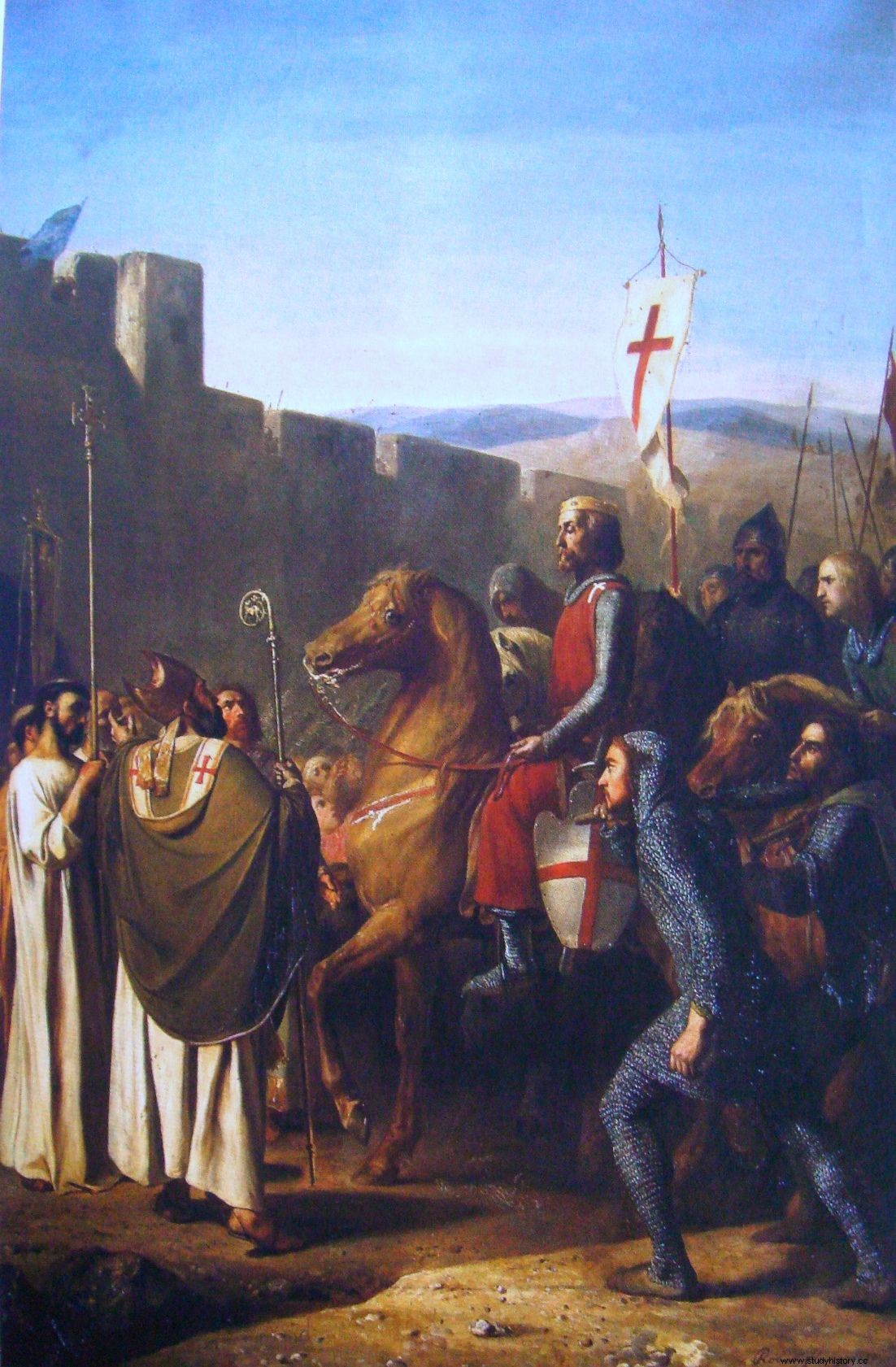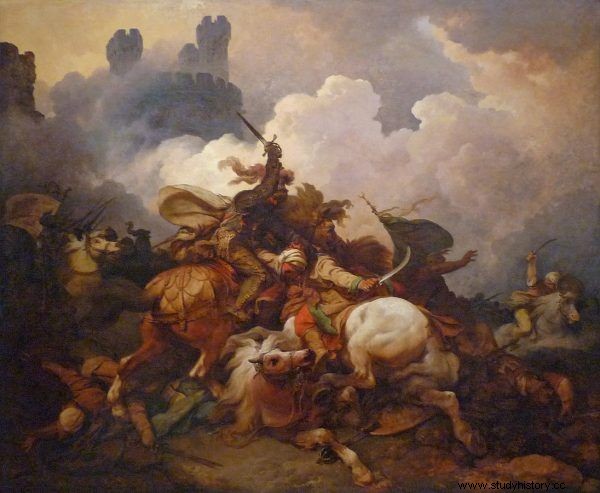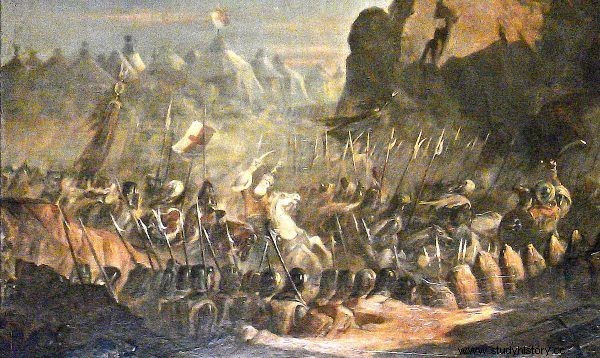When the pope called for the organization of the first crusade, in a fiery speech he assured the pilgrims that ... they would dare with the treasures of their enemies. He sensed the demand well. Many knights went to the Holy Land only to make a private fortune. But did they actually succeed?
The main goal of the knights setting out on the Crusades was not to acquire otherworldly treasures in the Holy Land. As the French medievalist Régine Pernoud reminds us:
[The Crusaders] did not go (...) on a war expedition or conquest, they went on a pilgrimage . An armed pilgrimage, but a pilgrimage nonetheless. If we are not aware of this aspect, we will understand little of the Crusades, this powerful movement that shook the whole of Europe . 
Of course, as in any war, it was to be expected that the victors would divide the fortunes of the defeated among themselves. However, if someone wanted some profits, he was better off staying in Europe. There were plenty of conflicts on the spot to make some money. Meanwhile, the crusades were an expensive investment with enormous risk. And if it was only about money, it would probably be one of the worst investments in history.
"I will sell London if I can find a buyer"
The very organization of the trip to the Holy Land required a lot of money from the volunteers. They got it by getting into debt or selling off their properties. This was the case with many of the participants in the First Crusade, which took place between 1095 and 1099. Robert II the Short, the eldest son of William the Conqueror, pledged the principality of Normandy to finance his and his army's journey. In turn, Gottfried of Bouillon, Duke of Lorraine, sold the County of Verdun and other lands.
The situation did not change later either. In 1101, Odo Arpin of Bourges, a French magnate, sold his possessions to King Philip I. The money was most likely necessary for him to take part in the crusade.

Robert II of the Short was willing to pledge his entire legacy - the sizeable principality of Normandy - to take part in the crusade. In this 1868 illustration by Joseph Martin Kronheim, we see this ruler at the head of his army in Palestine (public domain).
The King of England, Richard the Lionheart, also incurred huge costs to finance his participation in the Third Crusade (1189–1192). The brave ruler was ready for any expense. While raising money for a trip to the Holy Land, he swore: I will sell London if I can find a buyer . And he wasn't kidding. Although he did not find a buyer in London, Ryszard won the money by selling ... independence to the Scots. A huge sum, paid in 1189 by the Scottish King William the Lion, freed the country from English sovereignty. And she allowed the English monarch to set off on the much-desired pilgrimage.
From rags to riches to crusade version
The funds absorbed by the organization of the crusade were to be recovered, if possible, during the crusade. It was hoped that the expedition would be financially rewarded. Apparently it was not impossible:Fulcher of Chartres, the chronicler of the first Crusade, assured that whoever was poor in the West, the one in the East became rich.
What was the catch? Well, it was first necessary to reach this East. Meanwhile, the difference between the initial state of the crusader army and the final state was huge. Military historian John France calculated that the crusader's losses during the First Crusade were 75%. For comparison, the losses of the Wehrmacht during World War II amounted to 30% and were considered to be very high. In the same conflict, the losses of Americans during the three largest campaigns fluctuated between 1.5 and 3.66%. Anyway, even if you are critical of France's findings, the conclusion is clear: the First Crusade participants ended up dead rather than wealthy.
But when loot was found, it was reached greedily. Ryszard the Lionheart made a fish on his way to the Holy Land, and it was quite accidental. He conquered Cyprus and grabbed a lot of gold, amassed by Isaac Comnenus, the self-proclaimed ruler of the Island of Aphrodite. The King of England did not choose the means anyway. Already on the spot, in the Middle East, he did not despise even the attack on the rich caravan.
There were also individuals for whom crusades opened their career doors. This was the case with Baldwin, the third son of Count Boulogne and a participant in the First Crusade. He became first the Count of Edessa, and then - as Baldwin I - the king of Jerusalem. A similar promotion awaited his cousin, who on the Old Continent was one of the many insignificant feudal lords. In the Holy Land, he inherited from a relative, first Edessa, and later also the Duchy of Jerusalem. And from an ordinary Baldwin of Le Bourg he transformed into King Baldwin II.

Baldwin of Boulogne was one of those crusaders who made the deal of his life on the crusade. He started out as the younger of the sons of an ordinary count, and ended up king of Jerusalem. In this 1840 painting by J. Robert-Fleury, we see Baldwin's entry into Edessa - his first success on his way to the royal crown (public domain).
The hero of the most spectacular career of the Crusades was Renald of Châtillon. This simple knight, who decided to go to the Holy Land, had neither money nor influential relatives. But he was handsome and caught the eye of Duchess Constance of Antioch . The Duchess was a widow and so far she was in no hurry to get married again. It rejected all candidates proposed by the King of Jerusalem and the Byzantine Emperor. She only changed her mind when she met Renald.
Many people were amazed that this lady, so significant, wealthy, of a high family, wife of an equally great senior, decided to marry an almost simple soldier Wondered the chronicler William of Tire. But Constance, as she decided, did so. In 1153, Renald married the Duchess and became Duke of Antioch.
It should be remembered, however, that not everyone found similar perspectives equally tempting. Being ruler of the Middle East country was a huge success ... but only for second-tier feudal lords in the style of both Baldwins. Those who had large estates in Europe looked at the matter differently. This is evidenced by the example of Henry, Count of Champagne and Richard the Lionheart's nephew.

The prince of wealthy Champagne did not see any benefits for himself in taking over the Jerusalem crown. Despite long persuasions from his uncle, Richard the Lionheart, he finally obeyed… his heart. In this painting by Philippe-Jacques de Loutherbourg, we see King Richard fighting at Accra (photo:Ji-Elle, license CC BY-SA 3.0).
Uncle Richard pressed Henry to marry the Queen of Jerusalem, Isabella. She suddenly widowed in 1192 after her husband was killed by the Assassins. Meanwhile, the ruler of Champagne was not eager to take on the hardships of defending the Kingdom of Jerusalem - or rather the remnants of it. He wanted to go back to his European county. However, when he saw the beautiful Izabela, he changed his mind. And he stayed by her side in the Holy Land.
The Crusades and the European economy
Though the crusaders sometimes managed to find real treasures, the occasional spoils of war were not enough to finance their expeditions. After all, it was not a raid on a neighboring county, but a long and very expensive journey. Suffice it to mention that the seventh crusade, organized by the French king, Saint Louis IX, cost more than six times the annual revenues of the French crown !
As time passed, newer and newer ways of getting the money needed for expeditions were invented. The rulers, of course, reached into the pockets of their subjects. In 1188, King Henry II Plantagenet, King of England, and Philip II Augustus, King of France taxed all those who did not embark on a crusade. In turn, Philip of Swabia, the king of Germany, in 1207 introduced a five-year tax intended to finance the crusade. His nephew, Emperor Frederick II, followed in his footsteps. In 1221 he gave a special tribute to his people from Sicily.
The process of selling off their estates by feudal lords was also improved. Previously, it was quite problematic. To simplify the complexities of property law a bit - relatives and fiefdoms had the right of first refusal. To help the crusaders, in 1145, however, Pope Eugene III ordered that they could dispose of real estate without looking at the previously privileged parties. This serious Church interference in economic affairs has revived the real estate market in Western Europe.
Knights-bankers
Perhaps the expeditions did not bring the expected spectacular profits, but they still brought a real revolution to the world of European finance. And this is due to the Templars and the Knights of St. . Their activity was a response to the needs of smaller groups of "ordinary" pilgrims. After all, between 1095, when Pope Urban II called for an expedition to the Holy Land, and 1291, when the Muslims conquered Akka, symbolically ending the presence of Latin states in the Middle East, not only the great expeditions of the barons went to Jerusalem.

Pope Eugene III wanted to facilitate the raising of funds for the crusades. A side effect was the partial liberation of the medieval real estate market. Mosaic of the Pope in a monastery in Bregenz (photo:Andreas Praefcke, public domain).
For small groups, traveling with a large amount of gold for long weeks was not a good idea. Their participants could at best wake up one day battered and with an empty purse. At worst, they might not wake up at all. So enterprising monks came to their aid. The process of establishing the first banks is described in a visual manner by Martin Bauer in his book Templars. Myths and Reality ":
Templar monastic houses not only sheltered people, but also their gold - like all monasteries, commanders enjoyed the inviolability status of holy places. However, just in case, the most important houses of the Templars were secured with thick walls and were protected by legions of knights. Whatever went to the strictly guarded treasuries of the order in Paris, London, La Rochelle or Tomar (Portugal), it was as safe as with God behind the stove .

The Knights Templar not only fought and looked after the pilgrims. They also acted as bankers of the Crusades. And like all bankers profited from it. A 19th-century painting by Claude Jacquand depicts the Templar's attack on Jerusalem in 1299 (photo:World Imaging, license CC BY-SA 3.0).
This situation was quickly taken advantage of. Anyway, the world changing by the crusades needed new financial instruments. The letters of credit issued by the Templars became them. As Martin Bauer points out, this brilliant invention was of great importance to travelers. He did not cause much work for the monks themselves:
With their letters of credit [the Templars] revolutionized international money transfer:at any branch of the Order, anyone could purchase this letter of credit and then exchange it for cash at another branch. For travelers, this was of invaluable importance:they no longer had to transport their gold for fear that they might be completely robbed.
As the payment streams often equalized - one traveler pays in A and takes cash in B, another pays in B, taking money in A - the order had to transport only net balances. These small amounts of gold were practically unnoticeable compared to the scale of the continuous flow of goods between religious houses (…).
So how much was earned?
The Crusades were the most expensive adventures of medieval knights, often leading to financial ruin - wrote the American medievalist Fred Cazel. This sentence is perhaps the best summary of the crusades. Indeed, if you only look at the participants of the seven Crusades, not many have been made.
The leaders of the first Crusade had the best success. Most of them stayed in the Holy Land, creating Latin states. Their companions were earning money on a smaller scale. But then it only got worse. The leaders of successive crusades that reached the Middle East lost both time and money . Then, if they were still alive, they returned to Europe.

It was easy to waste time, money and… life on the crusade. To gain anything - it was already an art! The 14th-century miniature shows the battle of the Antiochian Fortress (public domain).
If anyone made money from the crusades, it was not the crusaders, but ... the people responsible for supporting the crusades. The most striking example is the Venetians who lent a large sum of money to the participants of the Fourth Crusade. They also used them to fight Christians. The Crusaders along with the Venetians captured Zadar in 1202, a strategic port for Venetian trade. The city previously belonged to the Hungarian king.
During the expeditions, knightly orders, banking houses, merchants, shipowners grew richer ... In a sense, the European economy was the winner. Land trading was improved, new financial instruments appeared, the monetary system and banking developed, and attempts were made to unify the tax system.
Europe also won, as Steven Runciman emphasized in the introduction to his classic "The History of the Crusades", in terms of civilization. Until the First Crusade, the British historian wrote, the focus of our civilization was the Byzantine Empire and the countries of the Arab Caliphate. Before this movement was over, Western Europe took over the leadership of civilization . But how to rate it?
***
I understand the Crusades narrowly in the sense of the expeditions from 1095-1291 to the Holy Land, with particular emphasis on the so-called seven crusades. Therefore, I do not take into account the expedition against the Albigenses, the Reconquista or the struggle of the Teutonic Knights with Prussia and Lithuanians.
